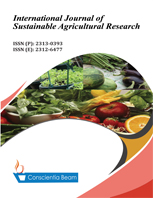Gene Action for Kernel Weight Per Plant in Spring Barley
DOI:
https://doi.org/10.18488/ijsar.v9i2.3021Abstract
The breeding and genetic peculiarities for kernel weight per plant in spring barley varieties of different origin (Ukraine, Western European countries, and Canada), purposes of usage (forage, malting, food) and botanical varieties (covered and naked, awned and awnless) under conditions of Ukrainian Forest-Steppe were revealed. In the diallel crossing scheme with only elite malting barley varieties accordance with the additive-dominant system and overdominance in loci were found. The manifestation of kernel weight per plant was reliably increased by the dominant effects. Accordingly to the indicator of the degree of phenotypic dominance, parameters of genetic variation, graphical regression analysis, effects of GCA and constants of SCA in the hybrid populations will be effective final selection for high kernel weight per plant in later generations, when dominant alleles become homozygous. When different botanical varieties were involved in crosses much more complex gene action for the trait manifestation with strong epistasis and multidirectional dominance were determined. Thus, it is theoretically possible to select plants with high productivity on recessive or dominant basis. The negative aspect is that it will require further extensive evaluation of the splitting generations. Awned spring barley varieties Datcha and MIP Myroslav, as well as awnless variety Kozyr can be used as an effective genetic source for involvement in crossings aimed to improving the kernel weight per plant. Naked spring barley varieties require more breeding improvement in plant productivity compare to covered ones.

